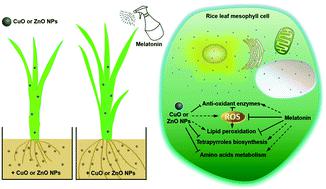当前位置:
X-MOL 学术
›
Environ. Sci.: Nano
›
论文详情
Our official English website, www.x-mol.net, welcomes your
feedback! (Note: you will need to create a separate account there.)
Melatonin enhances metallic oxide nanoparticle stress tolerance in rice via inducing tetrapyrrole biosynthesis and amino acid metabolism
Environmental Science: Nano ( IF 5.8 ) Pub Date : 2021-07-06 , DOI: 10.1039/d1en00244a Yue Song 1, 2, 3, 4, 5 , Binqiang Wang 3, 4, 5, 6 , Dengying Qiu 3, 4, 5, 7, 8 , Zhenming Xie 3, 4, 5, 6 , Shang Dai 3, 4, 5, 6 , Chao Li 9, 10, 11, 12, 13 , Shouling Xu 3, 4, 5, 7, 8 , Yunchao Zheng 1, 2, 3, 4, 5 , Shan Li 1, 2, 3, 4, 5 , Meng Jiang 1, 2, 3, 4, 5
Environmental Science: Nano ( IF 5.8 ) Pub Date : 2021-07-06 , DOI: 10.1039/d1en00244a Yue Song 1, 2, 3, 4, 5 , Binqiang Wang 3, 4, 5, 6 , Dengying Qiu 3, 4, 5, 7, 8 , Zhenming Xie 3, 4, 5, 6 , Shang Dai 3, 4, 5, 6 , Chao Li 9, 10, 11, 12, 13 , Shouling Xu 3, 4, 5, 7, 8 , Yunchao Zheng 1, 2, 3, 4, 5 , Shan Li 1, 2, 3, 4, 5 , Meng Jiang 1, 2, 3, 4, 5
Affiliation

|
The overuse of metallic oxide nanoparticles (NPs) has caused a burst of their enrichment in paddy fields. Several findings have reported that the NPs of ZnO and CuO have an adverse impact on plant growth, while the potential mechanism of rice response to the NPs of metallic oxides remains largely unknown. In our research, we found that pretreatment with different concentrations of ZnO and CuO NPs greatly increased the biosynthesis and accumulation of melatonin and its precursors (serotonin, tryptamine, and tryptophan), and induced the transcription of melatonin biosynthetic genes in rice seedlings. Foliage sprayed melatonin greatly enhanced the tolerance to metallic oxide NPs toxicity in rice plants as evidenced by reduced inhibition of plant growth and enhanced biosynthesis of tetrapyrrole in rice seedlings. Exogenous melatonin significantly alleviated metallic oxide NPs-induced oxidative stress with decreased reactive oxygen species (ROS), and increased the activity and gene expression of major antioxidant enzymes. Moreover, the melatonin supplement greatly increased the total amino acid content under metallic oxide NPs treatment in rice leaves. In summary, our findings reveal that melatonin is related to metallic oxide nanoparticle-participated molecular, biochemical, and physiological alterations by accelerating tetrapyrrole biosynthesis and amino acid metabolism in rice.
中文翻译:

褪黑激素通过诱导四吡咯生物合成和氨基酸代谢增强水稻对金属氧化物纳米颗粒的胁迫耐受性
金属氧化物纳米粒子 (NPs) 的过度使用已导致它们在稻田中的大量富集。一些研究结果表明,ZnO 和 CuO 的 NPs 对植物生长有不利影响,而水稻对金属氧化物 NPs 的潜在反应机制仍然未知。在我们的研究中,我们发现用不同浓度的 ZnO 和 CuO NPs 预处理大大增加了褪黑激素及其前体(5-羟色胺、色胺和色氨酸)的生物合成和积累,并诱导了水稻幼苗中褪黑激素生物合成基因的转录。叶面喷洒褪黑激素大大增强了水稻对金属氧化物 NPs 毒性的耐受性,这可以通过减少对植物生长的抑制和增强水稻幼苗中四吡咯的生物合成来证明。外源性褪黑激素显着减轻了金属氧化物纳米颗粒诱导的氧化应激,降低了活性氧 (ROS),并增加了主要抗氧化酶的活性和基因表达。此外,在金属氧化物NPs处理下,褪黑激素的补充大大增加了水稻叶片中的总氨基酸含量。总之,我们的研究结果表明,褪黑激素通过加速水稻中四吡咯的生物合成和氨基酸代谢,与金属氧化物纳米颗粒参与的分子、生化和生理变化有关。在金属氧化物NPs处理下,褪黑激素的补充大大增加了水稻叶片中的总氨基酸含量。总之,我们的研究结果表明,褪黑激素通过加速水稻中四吡咯的生物合成和氨基酸代谢,与金属氧化物纳米颗粒参与的分子、生化和生理变化有关。在金属氧化物NPs处理下,褪黑激素的补充大大增加了水稻叶片中的总氨基酸含量。总之,我们的研究结果表明,褪黑激素通过加速水稻中四吡咯的生物合成和氨基酸代谢,与金属氧化物纳米颗粒参与的分子、生化和生理变化有关。
更新日期:2021-07-06
中文翻译:

褪黑激素通过诱导四吡咯生物合成和氨基酸代谢增强水稻对金属氧化物纳米颗粒的胁迫耐受性
金属氧化物纳米粒子 (NPs) 的过度使用已导致它们在稻田中的大量富集。一些研究结果表明,ZnO 和 CuO 的 NPs 对植物生长有不利影响,而水稻对金属氧化物 NPs 的潜在反应机制仍然未知。在我们的研究中,我们发现用不同浓度的 ZnO 和 CuO NPs 预处理大大增加了褪黑激素及其前体(5-羟色胺、色胺和色氨酸)的生物合成和积累,并诱导了水稻幼苗中褪黑激素生物合成基因的转录。叶面喷洒褪黑激素大大增强了水稻对金属氧化物 NPs 毒性的耐受性,这可以通过减少对植物生长的抑制和增强水稻幼苗中四吡咯的生物合成来证明。外源性褪黑激素显着减轻了金属氧化物纳米颗粒诱导的氧化应激,降低了活性氧 (ROS),并增加了主要抗氧化酶的活性和基因表达。此外,在金属氧化物NPs处理下,褪黑激素的补充大大增加了水稻叶片中的总氨基酸含量。总之,我们的研究结果表明,褪黑激素通过加速水稻中四吡咯的生物合成和氨基酸代谢,与金属氧化物纳米颗粒参与的分子、生化和生理变化有关。在金属氧化物NPs处理下,褪黑激素的补充大大增加了水稻叶片中的总氨基酸含量。总之,我们的研究结果表明,褪黑激素通过加速水稻中四吡咯的生物合成和氨基酸代谢,与金属氧化物纳米颗粒参与的分子、生化和生理变化有关。在金属氧化物NPs处理下,褪黑激素的补充大大增加了水稻叶片中的总氨基酸含量。总之,我们的研究结果表明,褪黑激素通过加速水稻中四吡咯的生物合成和氨基酸代谢,与金属氧化物纳米颗粒参与的分子、生化和生理变化有关。











































 京公网安备 11010802027423号
京公网安备 11010802027423号